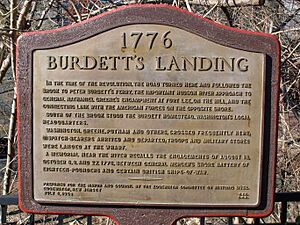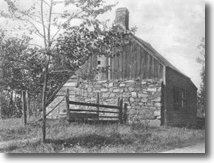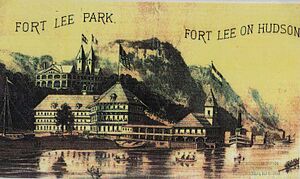Burdett's Landing facts for kids
Burdett's Landing, also known as Burdett's Ferry, was an important spot on the west side of the Hudson River in Edgewater, New Jersey. At first, ferries used this landing to carry farm goods from New Jersey over to New York. During the American Revolution, it was key for moving American supplies and soldiers. Later, in the 1800s, steamboats used it as a stop. Today, there is no longer a dock or ferry service at this historic location.
Contents
Where Was Burdett's Landing?
Burdett's Landing was right next to a 250-foot (76 m) tall cliff. This cliff was once called Mt. Constitution, but now it's known as Fort Lee Historic Park. The land slopes down on one side, making it easy to reach the water. Burdett's Landing was built in a small, sheltered area here.
An old description from 1900 said it was at the "bottom of a ravine" that made it easy to get to the top of the Palisades cliffs. It was also at the end of a small stream called Dead Brook. The landing itself doesn't exist anymore. The area is now part of the Edgewater Colony, where people own land together. A special plaque near the Edgewater Colony's meeting hall, about 100 feet (30 m) from the original spot, remembers Burdett's Landing.
History of Burdett's Landing
Early Days and the Bourdette Family
Long before Europeans arrived, the Lenape people lived in this area for thousands of years. Their numbers decreased as more colonists came, bringing illnesses and taking over their traditional lands. In the mid-1700s, a freed slave owned the land where Burdett's Landing would be. He received it for his hard work building a wall to support a road up the cliff.
In 1756, Stephen Bourdette, a merchant from New York, bought 400 acres (1.6 km2) of land in the Fort Lee and Edgewater area from the freedman. Stephen built a stone house in a forest clearing at the bottom of the gorge. He started a trading post and a ferry service for travelers and farmers.
In 1758, he began ferrying goods and people across the Hudson River using special boats called periaugas. These were row-and-sail boats with two masts that could carry heavy loads. Farmers used Burdett's Landing to send their crops to the Bloomingdale area of Manhattan (which was the west side of New York City back then). Stephen also ran larger sloops and a row-and-sail ferry to other parts of Manhattan.
Stephen's brother, Peter Bourdette, a farmer, moved to Burdett's Landing around 1760. Stephen later gave the property to Peter.
Burdett's Landing During the Revolutionary War
General George Washington ordered a fort to be built on the west side of the Hudson River. This land was part of the Bourdette property. Construction of the new fort, first called Fort Constitution, began in July 1776. It was located on the western side of the road leading up from the landing. At the same time, Fort Washington was being built almost directly across the river in New York.
The Bourdette's ferry service was taken over by the American Army. Peter Bourdette, a patriot, was happy to help and even offered the work of his slaves for the fort's construction. In September 1776, Fort Constitution was renamed Fort Lee, after General Charles Lee. George Washington used the stone Bourdette house as his headquarters when he was at Fort Lee. During this time, the ferry was vital for moving supplies and was the only link between Fort Lee and Fort Washington.
On October 27, 1776, there was a small fight near the ferry. Two British ships came up the river. They didn't do much damage to the Americans, but one of their ships was badly hit by American cannons before they left.
Peter Bourdette's 16-year-old son, also named Peter, helped the American war effort. In the week before Fort Lee was evacuated, he rowed back and forth across the river. He gathered information for General Washington about where the British forces were expected to move. The night before the battle for New York at Fort Washington, General Washington was rowed from Burdett's Landing to the middle of the Hudson River. There, he met with his senior officers to plan their strategy. On November 16, 1776, George Washington watched the battle for New York from the cliff above Burdett's Landing.
General Washington ordered the retreat from Fort Lee on November 20. This left the Bourdette family in danger as the enemy approached. Peter Bourdette sent his wife and family to safety, keeping his 16-year-old son to help protect their home. However, they couldn't stop the British soldiers and Hessian mercenaries from plundering the landing. Rachel Bourdette returned home to find all her supplies taken and her animals gone, except for one horse she had hidden. The family survived the winter, even though enemy troops often raided the area for supplies.
After the War: Steamboats and Resorts
After the war, the ferry service went back to helping farmers. Peter Bourdette lived to be 91 and passed away in 1823. Burdett's Landing changed a lot in the 1800s when steamboats became popular. It became an important stop for these new steam-powered ships. The Crystenah steamboat, for example, would leave New York City every evening and stop at Burdett's Landing.
A company called the Fort Lee & New York Steamboat Company, also known as The People's Ferry Company, started operating in 1832. They had at least five steamboats that stopped along the Hudson River, heading south and then crossing to New York City. This company ran until about 1920.
In the 1800s, there was a high demand for paving stones to build streets in New York City. Quarries opened on the Palisades cliffs to produce these paving blocks. Burdett's Landing became known as "Old Stone Dock" because it was used to transfer these cobblestones onto smaller boats headed for New York. This use ended in 1900 when the Palisades Interstate Park was created, stopping the destruction of the cliffs from quarrying.
During the 1800s, the area around Burdett's Landing slowly became a popular resort. New Yorkers saw this quiet, peaceful area as a great place for vacations. In 1878, the large Fort Lee Hotel opened near the landing. It was also called the Octagon House because of its unique design. Guests could reach the hotel by ferry from New York City.
The hotel had 60 rooms, each with gas lighting. It even had its own ferry service from its grounds to 129th Street in Manhattan. Guests could enjoy picnic areas, band concerts, a roller-skating rink, outdoor shows, and walking paths.
A fire destroyed the hotel in 1898, and it was never rebuilt. You can still see some of its old pilings (wooden posts) above the water just south of the Fort Lee cliff. As Edgewater became more industrial in the early 1900s, the idea of using the area as a resort faded. The original stone house built by Stephen Bourdette stood until 1899. In the 20th century, other ferries handled river crossings, and Burdett's Landing was no longer needed. Its former location became part of the Edgewater Colony when it was formed in 1948.





